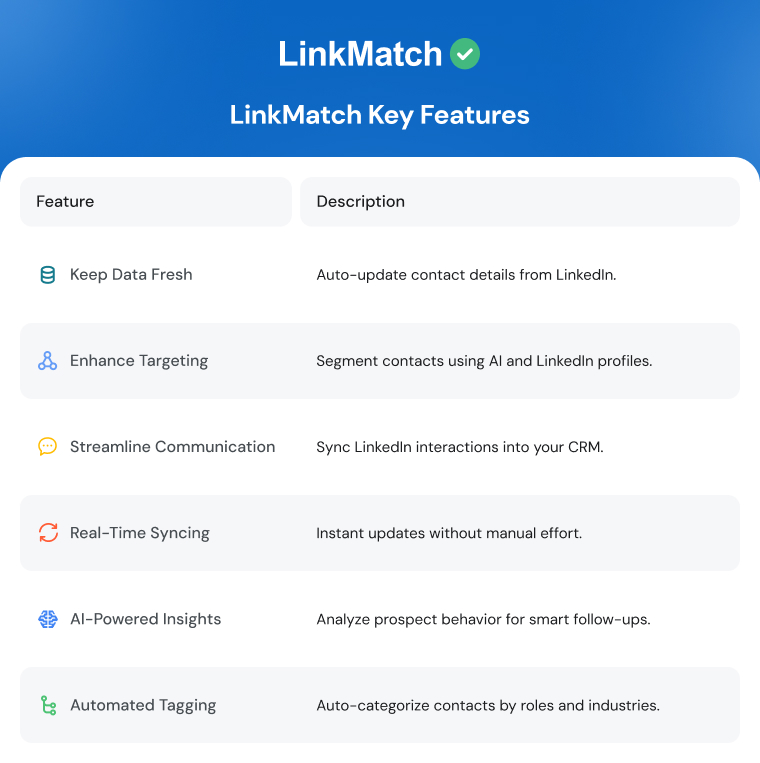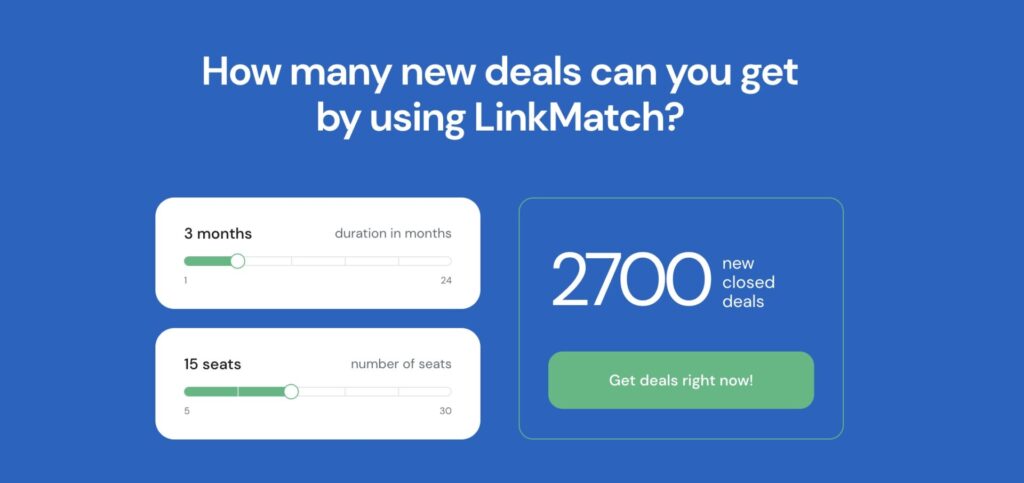This is a comprehensive guide on LinkedIn and CRMs for Sales. Read our related content on Zoho CRM & LinkedIn, Pipedrive & LinkedIn, HubSpot & LinkedIn, Insightly & LinkedIn, and on Close & LinkedIn.
Key Takeaways
- Expanding Sales Networks: Use LinkedIn’s enormous user base to enrich lead generation and build connections with key decision-makers.
- Data-Driven Sales Strategies: To tailor your sales approach, combine in-depth LinkedIn insights with CRM features like automation and advanced forecasting.
- Unified Communication & Reporting: Integrate LinkedIn interactions with your CRM to ensure every client touchpoint is tracked and actionable.
- Sales Revolution: The powerful integration between LinkedIn and leading CRMs via LinkMatch is transforming sales processes and driving unprecedented success.
In today’s hyper-connected world, sales professionals must harness every digital advantage to stay ahead. Integrating LinkedIn with top sales CRMs isn’t just a trend—it’s a revolution.
In this guide, we’ll show you how to combine the power of LinkedIn with leading CRM systems to expand your sales network, fine-tune your strategies, and close more deals faster.
The Power of LinkedIn in Sales
Expanding Your Sales Network
LinkedIn is not just a professional network—it’s an expansive resource for sales professionals. Here are some compelling statistics:
- Over 930 Million Members Worldwide: As of Q1 2023, LinkedIn had over 930 million members, a 17% increase from the previous year.
- Global Reach: With users across more than 200 countries, LinkedIn gives you direct access to influential decision-makers and industry leaders.
Discover top LinkedIn remote sales strategies to find prospects, build relationships, and close deals effectively.
Harnessing Market Intelligence
LinkedIn is a goldmine for real-time industry insights:
- Up-to-Date Trends: Monitor industry trends and competitor activities.
- Thought Leadership: Engage with experts to refine your messaging and strategies.
The LinkMatch Advantage
LinkMatch is the bridge that brings LinkedIn’s data directly into your CRM, ensuring your sales team never misses a beat. By automatically syncing your LinkedIn contacts and interactions, LinkMatch empowers you to:

Top Sales CRM Integrated with LinkMatch
Below are the leading CRMs fully compatible with LinkMatch, each offering unique benefits to boost your sales efforts in 2025:
Zoho CRM: A Sales Booster
Key Benefits:
- Lead Generation & Prospecting: Utilize detailed LinkedIn profiles to turn cold leads into warm prospects.
- Smart Contact Management: Organize and segment LinkedIn contacts for targeted outreach.
- Enhanced Analytics: Leverage enriched data for insights into customer behavior and market trends.
Statistics:
Over 150,000 businesses worldwide use Zoho CRM.
Pipedrive: Streamlining the Sales Process
Key Benefits:
- Activity Management: Align follow-ups with LinkedIn interactions for better pipeline control.
- Pipeline Optimization: Prioritize leads using real-time LinkedIn data.
- Comprehensive Reporting: Get a complete view of your sales performance with detailed analytics.
Statistics:
More than 100,000 active users trust Pipedrive across 170+ countries.
Source: Pipedrive
HubSpot CRM: Boosting Customer Engagement
Key Benefits:
- Personalized Marketing Campaigns: Use rich LinkedIn data to craft tailored campaigns.
- Accurate Lead Scoring: Enhance lead qualification by integrating real-time LinkedIn interactions.
- Deepened Relationships: Strengthen customer connections with actionable insights from LinkedIn.
Statistics:
HubSpot CRM is powering over 100,000 companies globally.
Insightly: Building Stronger Client Relationships
Key Benefits:
- Contact Insights: Enrich profiles with detailed LinkedIn data for better client interactions.
- Relationship Mapping: Visualize networks and identify potential partnership opportunities.
- Opportunity Tracking: Capitalize on sales leads faster with enhanced data.
Statistics:
Insightly is trusted by over 1,800 businesses globally.
Close CRM: Accelerating Sales Cycles
Key Benefits:
- Rapid Lead Engagement: Quickly identify and engage prospects using real-time data.
- Centralized Communication: Track every client interaction—including LinkedIn messages—in one place.
- Sales Automation: Reduce manual tasks and speed up your sales cycle.
Statistics:
Close CRM focuses on startups and SMBs, providing a tailored solution for rapid sales cycles.

Best Practices for Maximizing LinkedIn-CRM Integration
To truly harness the benefits of combining LinkedIn with your CRM, consider these strategies:
- Regular Data Syncing:
Ensure your CRM always reflects the most current LinkedIn information. Timely updates, such as a contact’s new role, can open up new sales opportunities. - Effective Contact Segmentation:
Organize your LinkedIn contacts by industry, role, or interests to enable precise and personalized outreach. - Thorough Interaction Tracking:
Record all LinkedIn communications within your CRM. A complete history of interactions improves relationship management and follow-up strategies. - Proactive Lead Nurturing:
Engage with your LinkedIn contacts by sharing relevant content, commenting on updates, and sending personalized messages to keep your brand top-of-mind. - Customized Communication:
Leverage insights from LinkedIn—such as recent posts or company updates—to tailor your outreach and build a stronger rapport.
Explore key networking strategies for sales success. Learn about leveraging LinkedIn, attending events, and building a strong personal brand.
Optimizing Sales Team Performance with Integration Training
Technology is only as effective as the team using it. To maximize the ROI of your LinkedIn-CRM integration:
- Comprehensive Training Sessions:
Conduct hands-on workshops focused on data syncing, contact segmentation, and leveraging LinkedIn insights for sales research. - Role-Specific Training:
Customize sessions for different team roles—account managers may focus on relationship building, while lead generators emphasize prospecting strategies. - Data-Driven Sales Techniques:
Train your team to analyze CRM data effectively. This will enable them to craft personalized sales approaches that resonate with prospects. - Encourage Knowledge Sharing:
Foster a culture of collaboration, where team members share best practices and success stories to refine the sales process continuously.
Conclusion
Integrating LinkedIn with top-tier CRMs via LinkMatch isn’t just a technological upgrade—it’s a strategic revolution. By harnessing LinkedIn’s vast network and real-time insights and fusing them with powerful CRM tools, you’re poised to drive significant growth and sales efficiency in 2025 and beyond.
Ready to Unlock Your Full Potential?
Start Your Free Trial
FAQs: LinkedIn & CRM Integration for 2025
How does integrating LinkedIn with my CRM benefit my sales process?
It enhances lead generation, organizes your contacts more efficiently, and provides real-time insights that empower personalized, data-driven sales strategies.
What CRM features are enhanced by LinkMatch’s integration?
Enhanced lead scoring, automated contact updates, unified activity tracking, and enriched analytics that lead to better decision-making.
What are the best practices for effective LinkedIn-CRM integration?
Regularly sync data, segment contacts for targeted outreach, track all interactions, nurture leads actively, and personalize communication using LinkedIn insights.
What training does my sales team need for effective integration?
To fully reap the integration’s benefits, comprehensive, role-specific training on data syncing, contact segmentation, and leveraging LinkedIn insights is essential.


